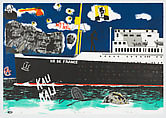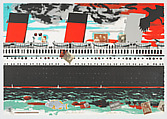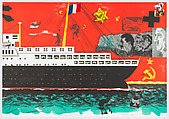The Big Cheese
Not on view
The Big Cheese is a colorful triptych consisting of three lithographs depicting a large passenger ship at sea, divided into three sections: the center (the Big Cheese; the name of the boat), the stern (Europe), and the bow (United States) in reference to its cross Atlantic voyage, the artist’s own history, and postwar geo-political European and American history. As a whole, the image, known as The Big Cheese, depicts the French ocean liner Ile de France. In 1949, the artist (then a boy) emigrated to the United States from France on the ship. The work is full of references to his history, that of his family, and that of postwar Europa and America, which either appear to be collaged or drawn on, often taking the form of graffiti markings. The work also makes reference to the celebrated French cheese, Ile de France, that share the name of the boat and is responsible for the title. Orenstein further evokes the cheese and the national flags of both France and America through visual elements. The sky for instance moves from a dark blue, almost nighttime hue above the bow, to lighter blue and white for the main ship, to deep red above the stern, thus evoking the form of the tricolor French flag, which is also imprinted on the logo for the cheese. Scattered throughout the work are images depicting such diverse figures as Max Beckmann, Jackson Pollock, Pablo Picasso, and Josef Stalin, as well as United States presidents as shown at Mount Rushmore.
Due to rights restrictions, this image cannot be enlarged, viewed at full screen, or downloaded.
This artwork is meant to be viewed from right to left. Scroll left to view more.






